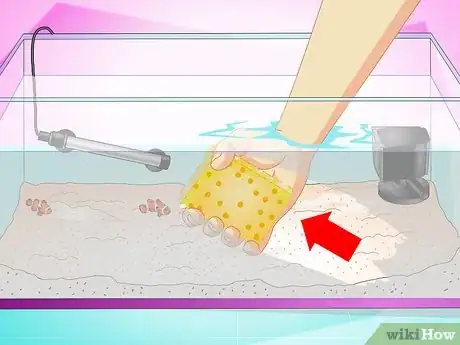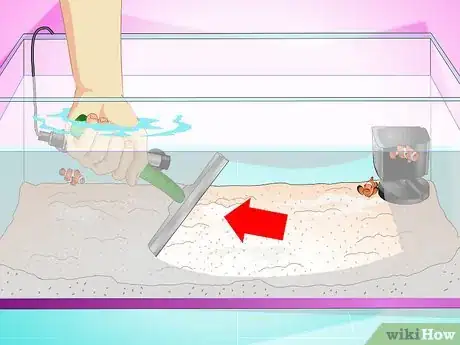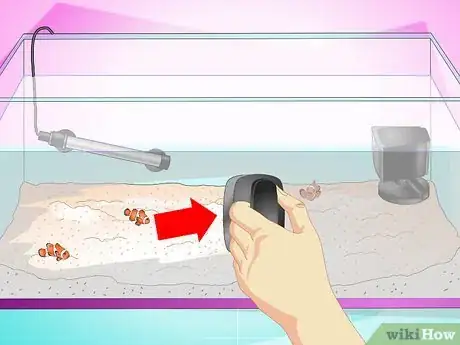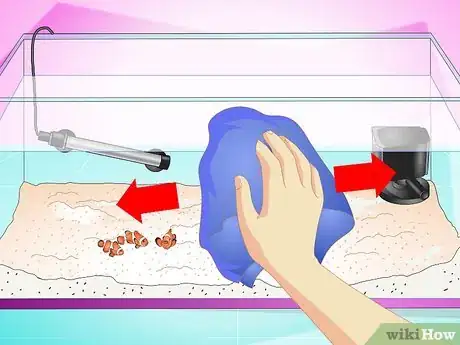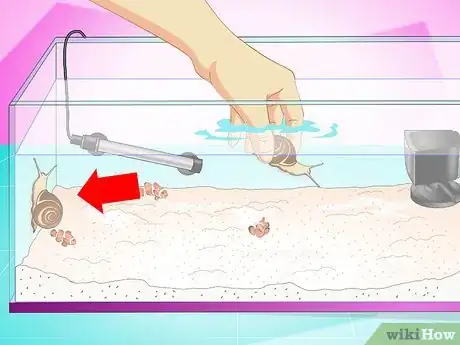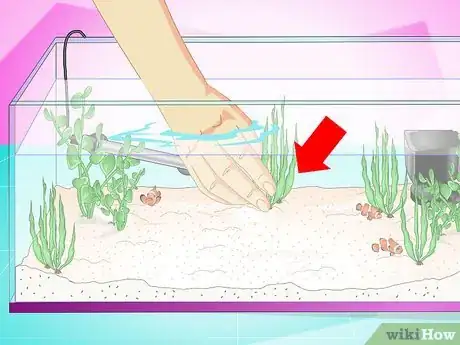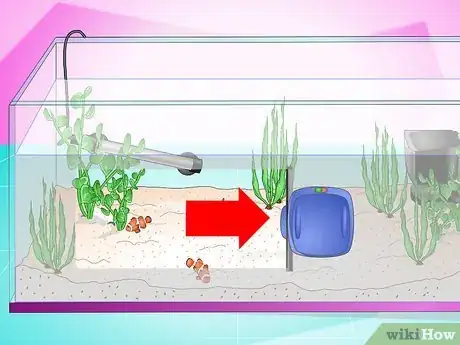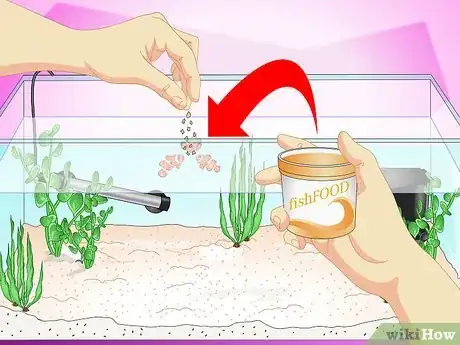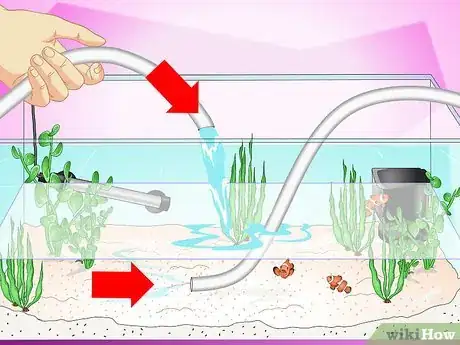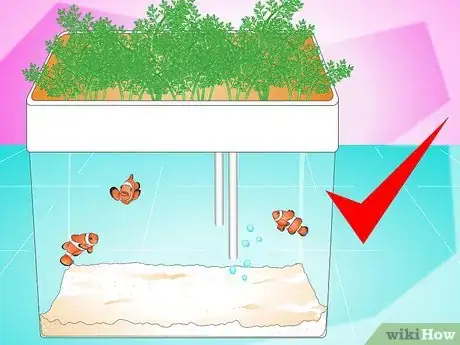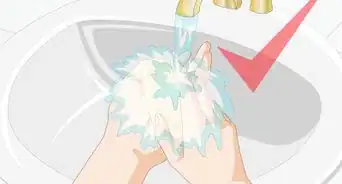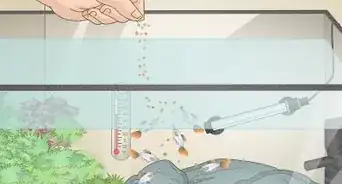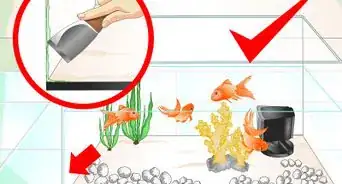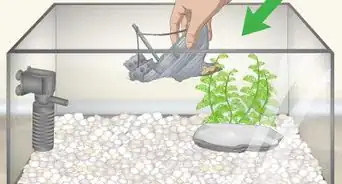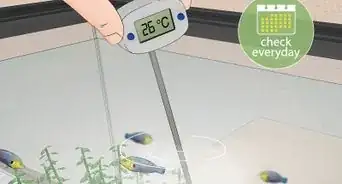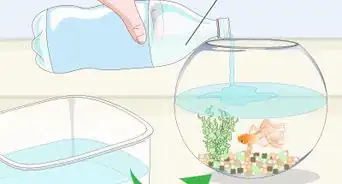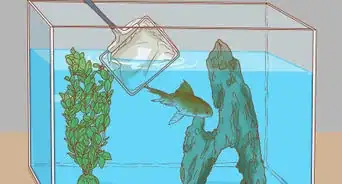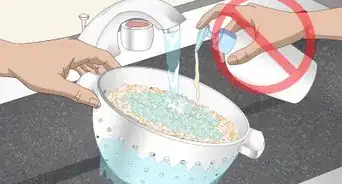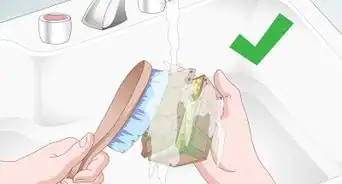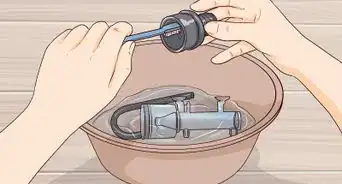This article was co-authored by Doug Ludemann. Doug Ludemann is the owner and operator of Fish Geeks, LLC, an aquarium services company based in Minneapolis, Minnesota. Doug has worked in the aquarium and fish-care industry for over 20 years, including having worked as a professional aquarist for the Minnesota Zoo and Shedd Aquarium in Chicago. He received his Bachelor of Science in Ecology, Evolution, and Behavior from the University of Minnesota.
There are 8 references cited in this article, which can be found at the bottom of the page.
This article has been viewed 144,305 times.
Cleaning aquarium glass is a relatively easy task. If you have some algae that needs to be removed, there are multiple methods for manually cleaning the glass. If you want a more hands-off approach, there are also species you can introduce to help you manage algae, and even automatic aquarium cleaners that you can buy. Lastly, there are several things you can do to make sure that algae does not have the nutrients it needs to thrive in your tank, which will make it much easier to maintain.[1]
Steps
Manually Cleaning the Glass
-
1Wipe it off. If you just have some mild algae buildup on the inside of your glass, it's pretty easy to wipe it off with a sponge. Be sure to use a clean sponge that will not introduce any chemicals or detergents into your aquarium. It's perfectly fine to do this while your fish are in the tank as long as you don't remove much of the water.
- You can use a sponge with an abrasive side if you need a little extra scrubbing power.
- If you don't want to put your arm in the tank, you can find a scrubber with a long handle at your local aquarium store.
-
2Use a scraper. If you just need to remove some tougher algae from the inside of your aquarium glass, it's easy to do with a scraper. Aquarium stores sell a special tool with a a scraper on one end and a brush on the other that is designed specially for this task.[2]
- Let the algae fall to the bottom of the tank as you are scraping and scrubbing. You can clean it up with an aquarium vacuum when you are finished.
- If the scraper is not working well enough, you can use a razor blade to scrape off the algae. Hold it at a 45 degree angle against the glass and scrape very carefully so as not to cut yourself.
- Do not empty the tank to do this. Removing more than 25% of the water from your aquarium can destroy the beneficial bacteria colonies that live there, which can cause your fish to die.
Advertisement -
3Try an aquarium magnet. If you don't want to stick your arm in the tank to clean the glass, there is another option. You can buy an aquarium magnet at your local pet or aquarium store, which will make this task much easier. The part of the magnet with the scrubbing pad goes on the inside of the glass, and the part with the handle goes on the outside. As you move the outside part around, the inside part will glide along the inside of your tank, cleaning the glass.[3]
- Be very careful not to bring your magnet within two inches of the sand or gravel at the bottom of the tank. If you get any abrasive materials stuck under the pad, you run the risk of scratching your glass.
- Be sure to rinse the cleaning pad after each use, and never leave the magnet in the tank when you are not using it. This will help prevent any sand from getting under the pad.
- Consider placing a piece of felt under the exterior part of the magnet to protect the glass.
- Aquarium magnets are available in a variety of sizes. The size of the magnet you choose will depend on the size of your tank. Although any size will work, it may be tedious to clean a very large tank with a very small magnet.
- The magnets are also available in different strengths. Use a stronger magnet for glass than for acrylic. (Be very careful not to get your fingers caught between them if you choose a strong magnet!)
- Some of these magnets float so you don't have to worry about fishing them out of the tank if they become dislodged. Some also have razor blade attachments for stubborn algae.
-
4Clean the outside. It's just as important to keep the outside of your aquarium glass clean as the inside, and this task is considerably easier. Simply use a lint-free cloth or soft piece of paper (coffee filters and newspaper both work well) and gently scrub the outside of your tank with warm water.
- Using chemical cleaners is not advised because it is possible that small particles could become airborne and contaminate the inside of your tank.
- If you must use a chemical cleaner, spray it onto your cloth well away from the aquarium, instead of spraying it onto the glass.
Letting Algae Eaters Do the Work for You
-
1Introduce algae eating species. If you want to get rid of algae without having to do any of the hard work yourself, consider introducing species of fish, snails, and crustaceans that eat algae. The right species for you will depend on whether you have a freshwater or saltwater aquarium, the size of your tank, and the other species that you already have, so be sure to research them before you bring them home. You don't want to end up with a fish that is too large for your tank or is aggressive with your other fish. Popular algae-eaters include:[4]
- Bristlenose plecostomus
- Amano shrimp
- Siamese algae eaters
- Twig catfish
- Otocinclus
- Rosy barbs
- Flag fish
- Ramshorn snails
- Nerite snails
-
2Try plants. Having plants in your aquarium can help prevent algae build up because they consume the same light and nutrients that algae does. The less of these resources there are available for algae, the less algae you will have.[5]
- Plants also add beauty to your aquarium and they give your fish a place to hide, so they are beneficial in many ways.
- When choosing plants for your aquarium, be sure to consider what conditions they thrive in. For example, some plants need more light than others and different plants flourish at different temperatures.[6]
-
3Get an automatic cleaner. If fish, snails, and plants just aren't doing a good enough job of eliminating algae for you, you can get an automatic aquarium glass cleaner to do the job for you. Just place the cleaner on the inside of your glass, turn it on, and walk away.
- This is a pricey option, at over $200. Automatic aquarium glass cleaners are available at aquarium stores and online.
- The automatic cleaner comes with a rechargeable battery and a replaceable scrubbing pad.
- The automatic cleaner cannot turn corners, so you will need to reposition it if you need it to clean more than one side of the tank.
Preventing Algae Buildup
-
1Eliminate excess nutrients.[7] Algae flourishes when there is too much phosphate and nitrogen in your tank. There are many different sources of these nutrients, so always be very cautious about what you are adding to your tank.[8]
- If you use tap water to replenish your tank, purify it with a reverse osmosis/deionizing unit to remove any unwanted nutrients. You can purchase units that attach directly to your faucet, providing purified water from your tap. If you choose to use a unit like this, be sure to change the filters as often as the manufacturer recommends.[9]
- If you purchase a saltwater mix, make sure to read the packaging carefully and only choose products that are nitrogen- and phosphate-free.
- Too much food can also be a source of nutrients for algae. To avoid this, make sure to only provide as much food as your fish can eat in a few minutes.[10]
- Too many fish in your tank can also cause increased levels of phosphate and nitrogen. If this seems to be a problem for you, consider moving some of your fish to another tank.[11]
- Algae also needs light to grow, so be careful not to leave the aquarium lights on more than necessary. About 10-12 hours per day is plenty.[12]
-
2Change the water. If you have persistent algae problems in your fish tank, and reducing the amount of nutrients has not yet solved the problem, you may need to change some of the water.[13] It is usually a bad idea to get rid of all of the water in your tank and start over. By doing this, you will be killing off all of the beneficial bacteria that your fish need to survive. Instead, replace 10-30% of the old water.[14]
- You can purchase an aquarium siphon to easily remove the old water from your tank.
- If you do this once a month, you will soon notice a significant difference in the amount of algae in your tank.
- Vacuuming the substrate and cleaning off any decorations you have in your tank may also help. You can purchase special aquarium vacuums that are designed for this purpose.
-
3Get a self-cleaning tank. If you have a small freshwater tank and you want less maintenance, consider investing in a new tank that cleans itself. There are two different types of self-cleaning tanks available, and both will significantly reduce the amount of time you spend cleaning, so they may be worth the investment.[15]
- Some self-cleaning tanks use a gentle pump to remove dirty water. All you need to do is turn the pump on and place a cup under the pump to catch the dirty water. Then add clean water to replenish your tank. The pump is not strong enough to bother the fish, so you can leave them in the tank.
- Other self-cleaning tanks incorporate small gardens on top to naturally clean the tank. This is done automatically, so there's nothing you need to do.
Expert Q&A
Did you know you can get expert answers for this article?
Unlock expert answers by supporting wikiHow
-
QuestionWhat are some ways I can prevent algae build up on aquarium glass?
 Doug LudemannDoug Ludemann is the owner and operator of Fish Geeks, LLC, an aquarium services company based in Minneapolis, Minnesota. Doug has worked in the aquarium and fish-care industry for over 20 years, including having worked as a professional aquarist for the Minnesota Zoo and Shedd Aquarium in Chicago. He received his Bachelor of Science in Ecology, Evolution, and Behavior from the University of Minnesota.
Doug LudemannDoug Ludemann is the owner and operator of Fish Geeks, LLC, an aquarium services company based in Minneapolis, Minnesota. Doug has worked in the aquarium and fish-care industry for over 20 years, including having worked as a professional aquarist for the Minnesota Zoo and Shedd Aquarium in Chicago. He received his Bachelor of Science in Ecology, Evolution, and Behavior from the University of Minnesota.
Professional Aquarist
-
QuestionHow can I clean hard scale outside of my aquarium?
 Community AnswerChildren's unscented wet-wipes. The generic ones from Wal-Mart will work just fine.
Community AnswerChildren's unscented wet-wipes. The generic ones from Wal-Mart will work just fine. -
QuestionEven after cleaning the water in my aquarium, it appears cloudy. What should I do?
 Community AnswerEven though the water may be clean, the glass may be dirty. Try cleaning the glass.
Community AnswerEven though the water may be clean, the glass may be dirty. Try cleaning the glass.
References
- ↑ Doug Ludemann. Aquarium Care Professional. Expert Interview. 27 August 2019.
- ↑ http://www.ratemyfishtank.com/blog/cleaning-algae-off-tank-glass-properly
- ↑ http://aquariumnetwork.com/blog/best-magnet-to-clean-aquarium-glass/
- ↑ http://www.ratemyfishtank.com/blog/cleaning-algae-off-tank-glass-properly
- ↑ Doug Ludemann. Aquarium Care Professional. Expert Interview. 27 August 2019.
- ↑ Doug Ludemann. Aquarium Care Professional. Expert Interview. 27 August 2019.
- ↑ Doug Ludemann. Aquarium Care Professional. Expert Interview. 27 August 2019.
- ↑ http://www.saltwatersmarts.com/rid-green-hair-algae-remove-stop-growth-2507/
- ↑ http://www.liveaquaria.com/PIC/article.cfm?aid=65
- ↑ http://www.ratemyfishtank.com/blog/cleaning-algae-off-tank-glass-properly
- ↑ http://www.saltwatersmarts.com/rid-green-hair-algae-remove-stop-growth-2507/
- ↑ http://www.ratemyfishtank.com/blog/cleaning-algae-off-tank-glass-properly
- ↑ Doug Ludemann. Aquarium Care Professional. Expert Interview. 27 August 2019.
- ↑ https://pethelpful.com/fish-aquariums/Aquarium-Algae-Control-How-to-Get-Rid-of-Algae-in-a-Fish-Tank
- ↑ http://www.aquariphiles.com/best-self-cleaning-fish-tank/
- ↑ http://www.ratemyfishtank.com/blog/cleaning-algae-off-tank-glass-properly
- ↑ http://www.firsttankguide.net/waterchange.php
About This Article
To clean aquarium glass, use a clean sponge to wipe off the algae buildup from the inside of the tank while the fish are still in it. If you’d rather not put your arm in the tank, you can buy a scrubber with a long handle at a local aquarium store. For tougher algae, scrape it away from the glass with a scraper, letting the algae fall to the bottom of the tank. Then, use an aquarium vacuum to suck up the debris from the rocks when you’re done. Finally, clean the outside of the glass with a damp piece of newspaper or other lint-free paper so it doesn’t leave streaks. To learn how to add algae-eating species to your tank to keep it clean, read on!

